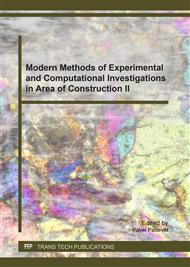p.128
p.136
p.142
p.148
p.153
p.159
p.167
p.172
p.178
Adaptive Boundaries of Wang Tiles for Heterogeneous Material Modelling
Abstract:
This contribution deals with algorithms for the generation of modified Wang tiles as a tool for the heterogeneous materials modelling. The proposed approach considers material domains only with 2D hard discs of both equal and different radii distributed within a matrix. Previous works showed potential of the Wang tile principles for reconstruction of heterogeneous materials. The main advantage of the tiling theory for material modelling is to stack large/infinite areas with relative small set of tiles with emphasis on a periodicity reduction in comparison with the traditional Periodic Unit Cell (PUC) concept. The basic units of the Wang Tiling are tiles with codes (colors) on edges. The algorithm for distribution of hard discs is based on the molecular dynamics to avoid particles overlapping. Unfortunately the nature of the Wang tiling together with molecular dynamics algorithms cause periodicity artefacts especially in tile corners of a composed material domain. In this paper a new algorithm with adaptive tile boundaries is presented in order to avoid edge and corner periodicity.
Info:
Periodical:
Pages:
159-166
Citation:
Online since:
March 2017
Authors:
Price:
Сopyright:
© 2017 Trans Tech Publications Ltd. All Rights Reserved
Share:
Citation:


